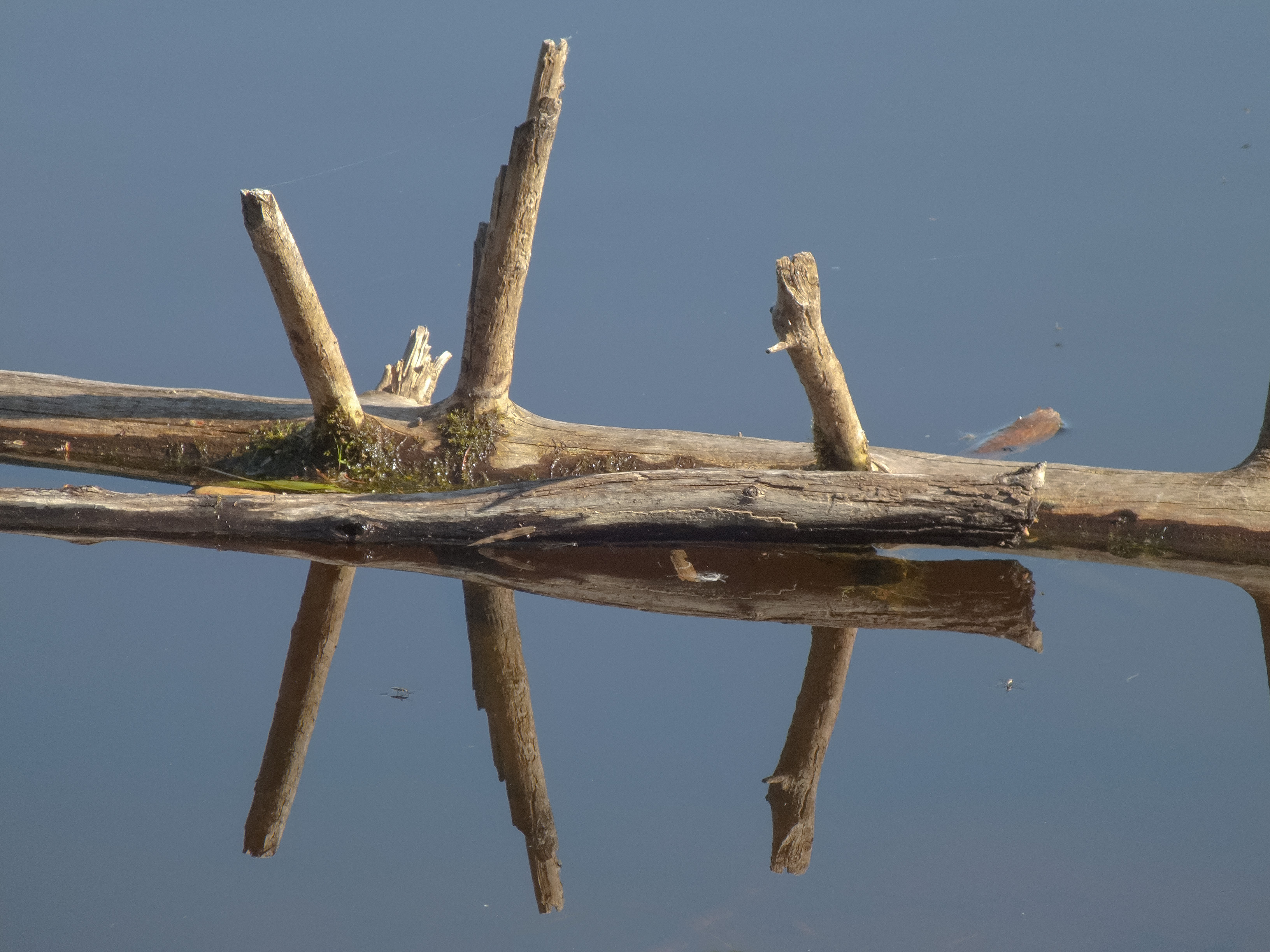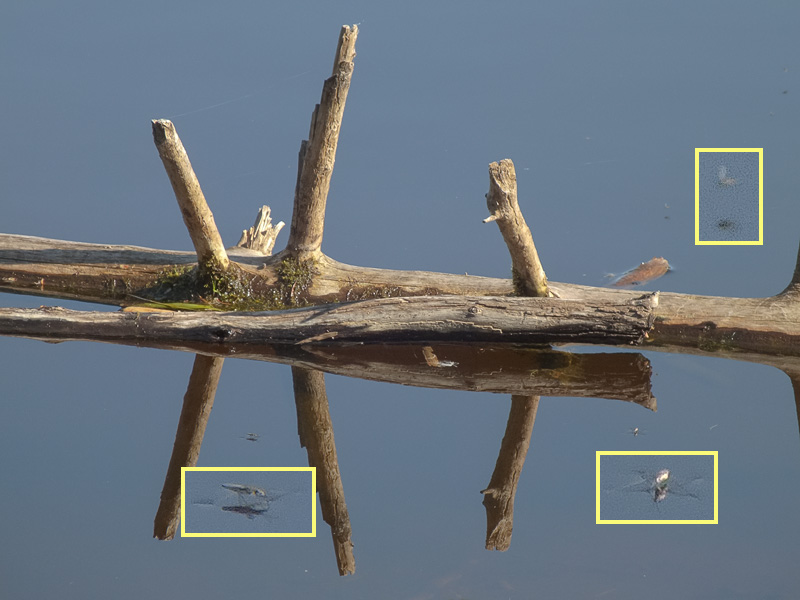It’s been a while, but I’ve been swamped. I’ve shot close to a thousand images (lots of fast sequences at Nick’s baseball game last Friday) and have had to trudge through the processing. I’ve also gone through the F770EXR Stockholm images with only the few D7000 images left to process before I can continue that review / travel post as well.
So … the Beaver Trail is a part of the Stony Swamp system of trails and I paused when I reached the part of this trail that contains an large pond with a beaver lodge in the middle. So now I walk onto the wooden platform that overlooks the pond and surrounding shoreline. There are trees along my side of the pond, where the trail that branched to this platform continues on to become the Kingston trail, going half way to Toronto. A long walk for another day :-)
The first thing I note are a pair of nesting Canada Geese right in front of me. So I set the HS25 to 2x digital zoom and shoot the goose …
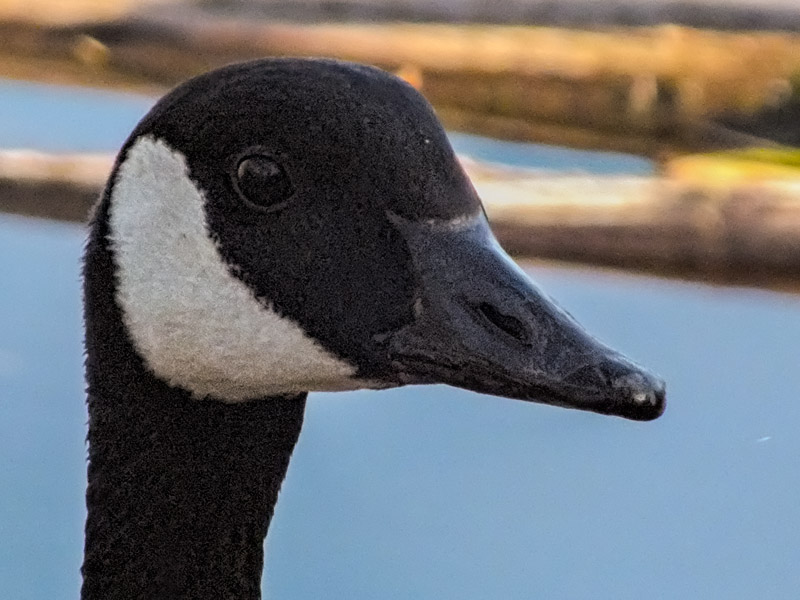
HS25 1600iso (!) g/5.6 1/1000 -2/3ev
So … 1600ISO. Wow. That’s what happens, though, when you expose against something black on such a narrow field of view (FOV.) One thing I have noticed is that the HS25’s meter exposes differently when in digital zoom mode. This surprised me, since the zooming is an after the fact process. But it is probable that they have chosen to somehow send the post-processed image to the meter. Which is quite interesting …
This image is grainy as heck … yet it is crisp and there is plenty of real detail on the face of the goose. The bill looks quite good, despite the grain. So although this is no show piece, it is certainly a pleasant reminder of the walk. That log you see in behind gets more focus later.
Next, I shoot The other goose (sleeping, as you can see by the white over the eyes) at full zoom without the digital augmentation.

HS25 400iso f/5.6 1/250 -2/3ev
Dropping two stops of ISO really helps the detail. This is a pretty magnificent image of feather detail for 400ISO on a 1/2” sensor shot in JPEG.
Now a little preening action …
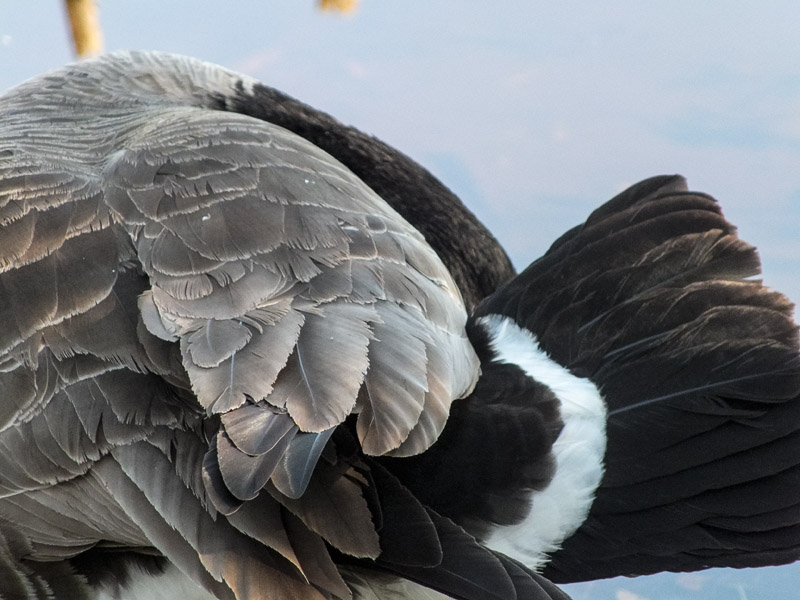
HS25 640iso f/5.6 1/250 -2/3ev
So … these last three images are all shot at 126mm, or 687mm in 35mm terms. That’s a lot of magnification and one cannot help but be impressed that this fairly slow telescope of a lens resolves this well in the shady woods late in the evening. Kudos to Fuji.
Here’s an observation:
The HS25 will try to maintain the minimum 1/250s speed for its 687mm, which implies that Fuji trust there is to be good for about 1.5 stops. Not bad. Further, you can see that the ISO rose to 1/1000s when the 2x digital magnification was applied. This further strengthens my theory that Fuji are magnifying the image early in the process so they can integrate the metering and the IS system to better handle the higher magnifications. This is the essence of smart digital zoom and more kudos to Fuji.
Let’s momentarily switch to the F770EXR interpretation of this scene. First, a framing shot of both geese. It’s shot at 226mm EFL, which is considerably less than the 687mm I was using with the HS25, and this allows lower ISO and slower shutter. The result, in RAW, is pretty excellent.
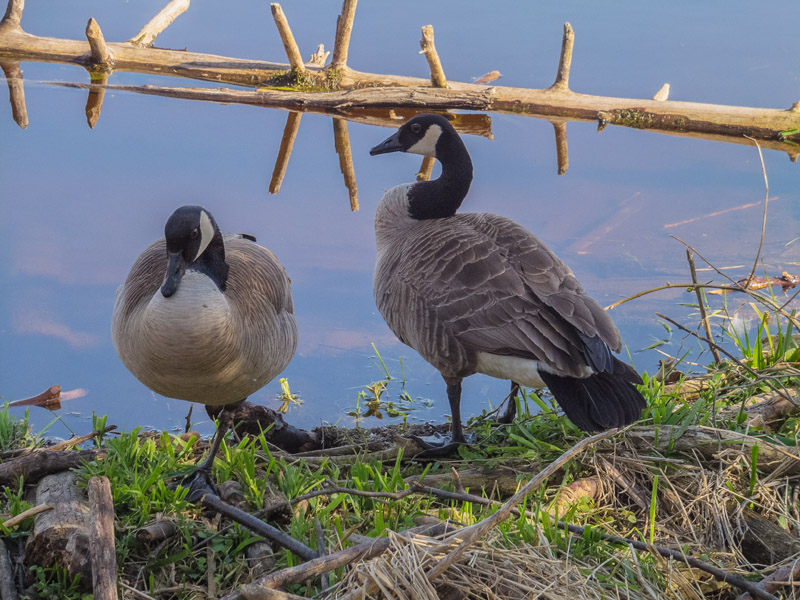
F770EXR 100iso f/5.9 1/120 -2/3ev
I tend to process RAW in a more open fashion, probably because I have more headroom to retain fine details while handling noise. Of course, here I have tons of leeway as the ISO is very low.
The next shot cozies up to the sleeper, whose eye has popped open to watch me I suppose. I am not in love with the color cast I chose for this one. Maybe a tad too warm. But the detail is magnificent.
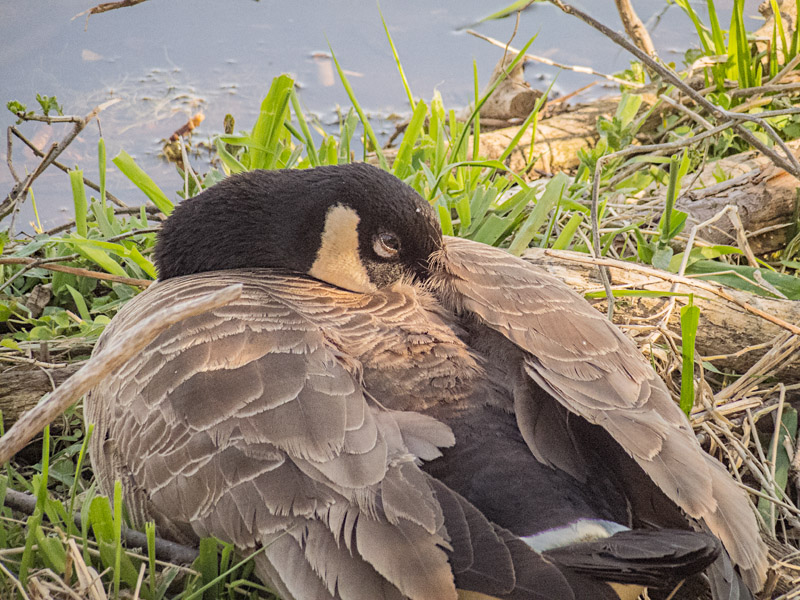
F770EXR 320iso f/5.3 1/125 0ev
I decided to expose a bit brighter since there was a lot of shade and I was shooting RAW. This is max zoom, or about 500mm. The crop factor actually suggests that this is 502mm EFL.
Nothing to really fault in the feather detail, but there might be a hint of CA on the white patch at the tail. I could handle that better in ACR / LR but I have been processing a lot of images lately.
And finally, a couple of images from the D7000. The first is a crop to basically match the FOV of the two Fujis.

Nikon d7000 + 18-200VR 640iso f/10 1/160 -2/3ev 300mm EFL
I also liked the log and the way the geese were standing at this moment.
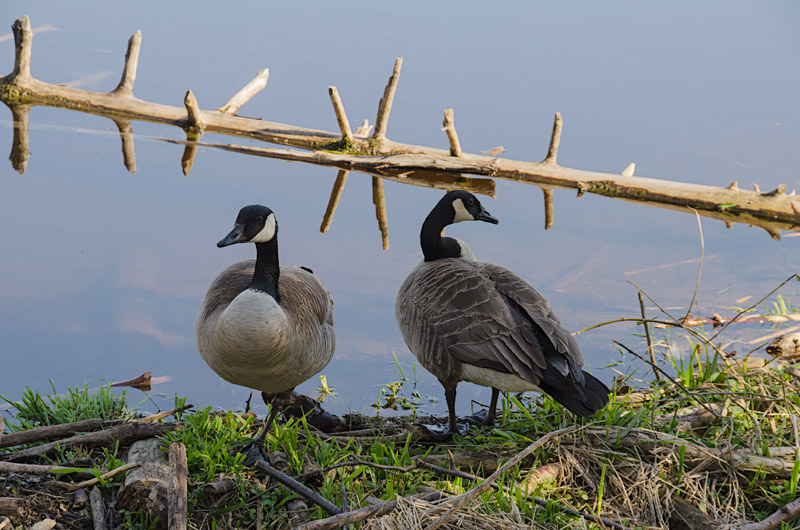
D7000 + 18-200VR 640iso f/10 1/320 -2/3ev
The feather detail is fine and the log is handled a bit better than the smaller sensors can handle it simply because they don’t have the dynamic range. They are far better than most small sensor cameras, but this is a different league.
Now … turning our attention back to the HS25 and that log that floats in behind the geese. I really like this thing … it has interesting detail, and interesting reflection in the calm water, and there are some small details around it that can be seen at pixel peeping levels.

HS25 125iso f/5.6 1/250 -2/3ev
Pixel peeping a JPEG from a small sensor you say? Sure. Why not? There is enough light on the subject and the ISO is low enough that the image should not be utterly disgusting at 100%, a common knock against EXR sensors. So let’s have a look.
It looks pretty “crispy” because it is downsized in display software. It will look different again for each one of you because you are using different monitors, with or without calibration, and with different rendering algorithms. So … the only way to see it properly is to click on it to open it in a browser and click again to open to 100%. It won’t win any beauty contests, but it.s interesting to look at.
And if you are looking for those little details I think are fun … here they are:
Again, expand that image to see the details at 100%. Impressive resolution for a 1/2” sensor in JPEG. In my opinion anyway.
I didn’t shoot any log closeups with the other cameras, so that’s that.
A few final images of the geese with the HS25, these processed more like the F770EXR image. I like this one for the more subtle tones. The lower ISO allows better detail, even though the magnification is way down too.
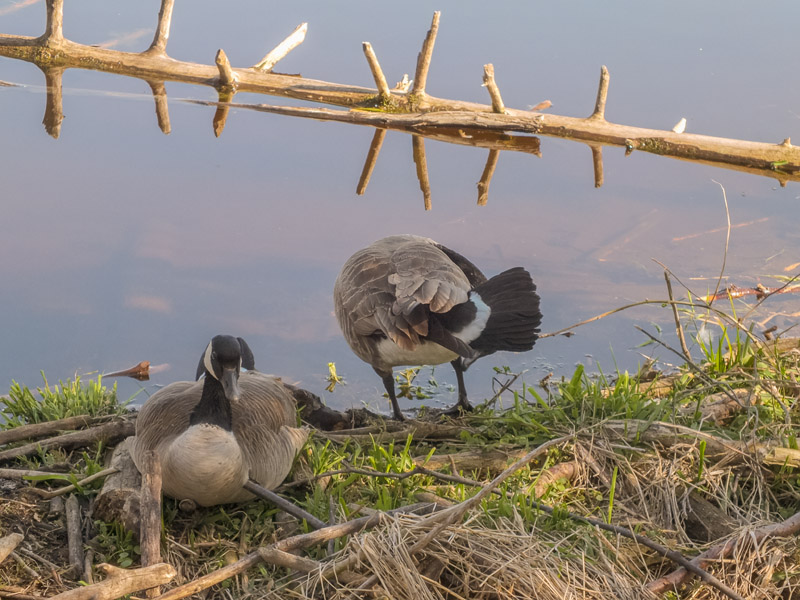
HS25 125iso f/5.6 1/150 -2/3ev
And this one is amusing because of the way the goose was bending over backwards to please his mate. :-)
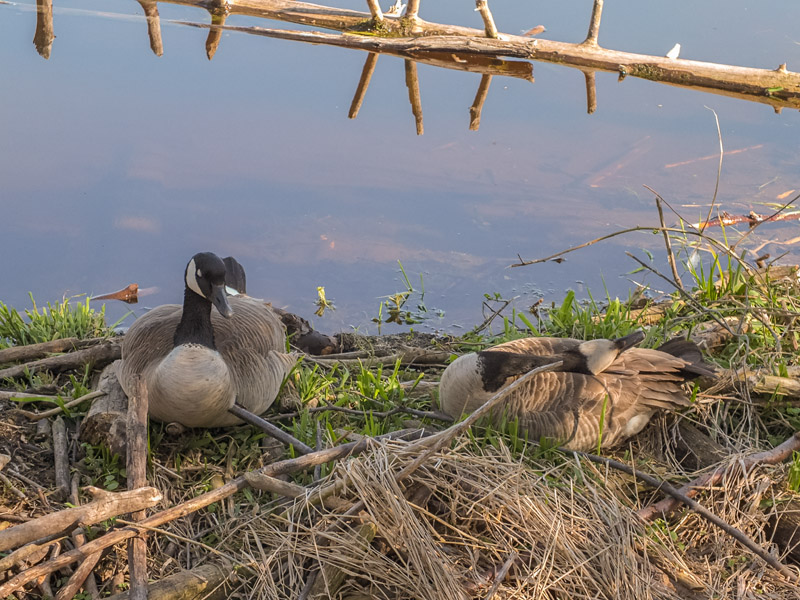
HS25 160iso f/5.6 1/150 -2/3ev
There is a second pair of geese nesting about 50 feet from where I stand on the platform. There is still sunlight on them as they wander about the shore line, so I catch a glimpse of their babies, something that has apparently eluded the pair that are so close to the platform.
I’m really pleased with the clarity and detail on this shot of a couple of babies in behind one of the parents.
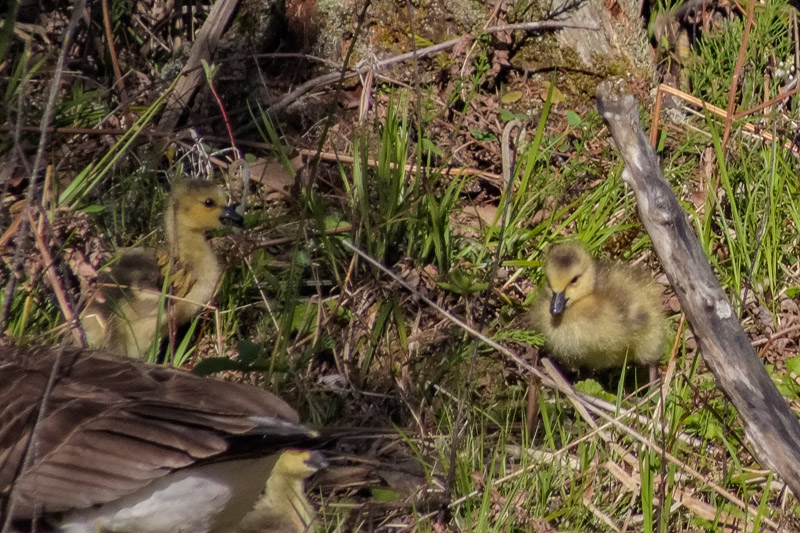
HS25 100iso f/5.6 1/550 -2/3ev
In fact, there were a lot of birds sharing the space. The guard rails on the elevated platform had seeds on almost every post, so birds would visit for the kiddies (none of whom were present while I was on the platform, which is a good thing as I was able to capture more images because of it.)
Here, a Red Winged Blackbird drops in for a seed.

HS25 100iso f/5.6 1/300 -2/3ev
The detail is adequate, but the bird was a long way away (30 feet) and this is cropped I believe. Still, nice to remember the bird.
The ubiquitous Black-Capped Chickadees are everywhere where there are seeds, so of course I have a field-day with them.
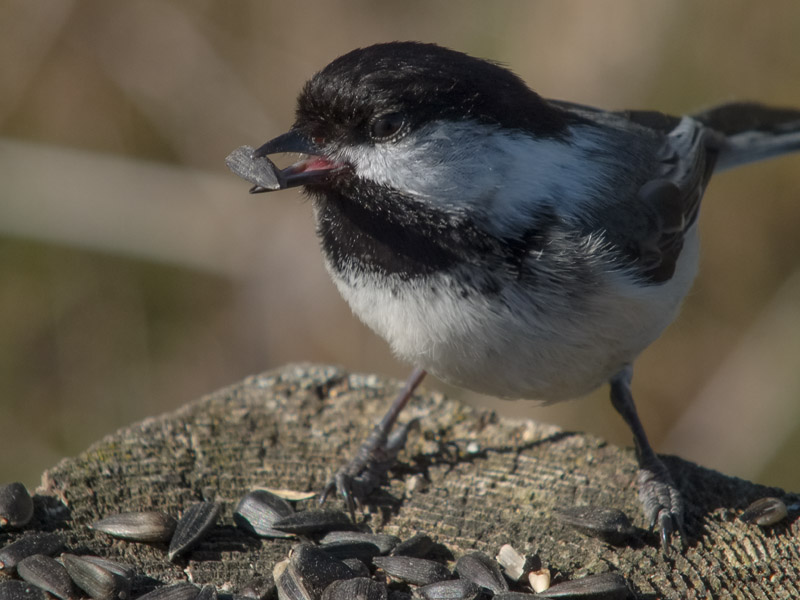
HS25 100iso f/6.4 1/280 -1ev
I dropped the exposure to –1ev so that I could protect the light spots on the birds. The dappled sunlight was starting to make things more difficult. But what about that feather detail? I’m pretty pleased.
And then a wonderful Nuthatch starting popping over for a seed about every two or three minutes. What a beautiful bird and what a treat!
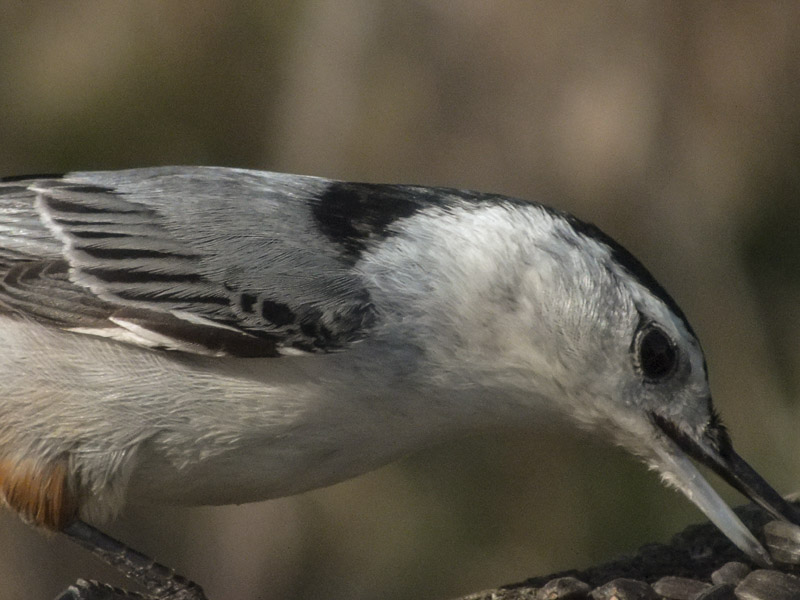
HS25 400iso f/6.4 1/1400s -1ev
You can see the dramatic increase in ISO and shutter speed. So what does that tell us? That I shot at 2x smart digital zoom. The result is not perfect, but I can’t really complain. The detail is pretty excellent.
Backing off the DZ, I get a more normal shot the next time he visits. Pretty bird, whose a pretty bird … sooooo cuuuuute ….
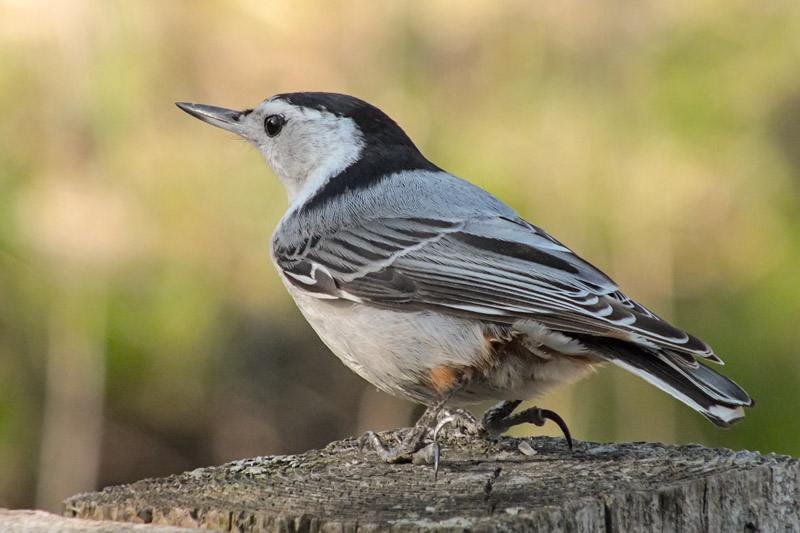
HS25 500iso f/6.4 1/250 -1/3ev
I look down to find a visitor at my feet. He stops when I look so I grab a quick shot. The detail is lovely.

HS25 400iso f/6.4 1/150 -1/3ev
The sunlight caught the white stripes on the body, blowing them sky high. Not a masterpiece, but again a nice reminder of the little fella’s presence.
And back where the Red-Winged Blackbird had been, a Blue Jay pops in for a moment. So cool.
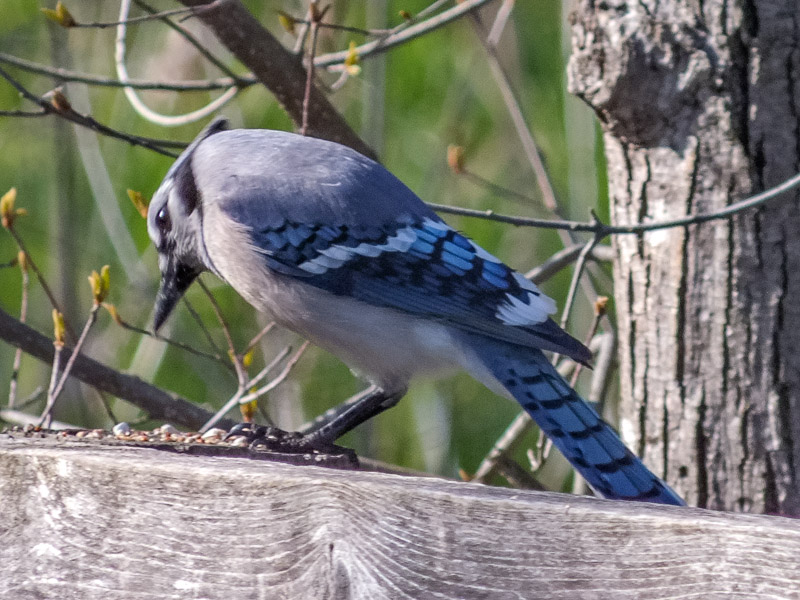
HS25 125iso f/6.4 1/250 -1/3ev
He’s not really holding still, so this image is weak. But it is the one I managed to grab with the HS25, so you get to see it.
Ok, I lied earlier … I shot the goose one more time. This was the moment I noticed that they have white feathers on their eye lids, which you see when they sleep. I wonder what evolutionary motivation was behind the appearance of these “kill me, I’m sleeping” signals on the face :-)
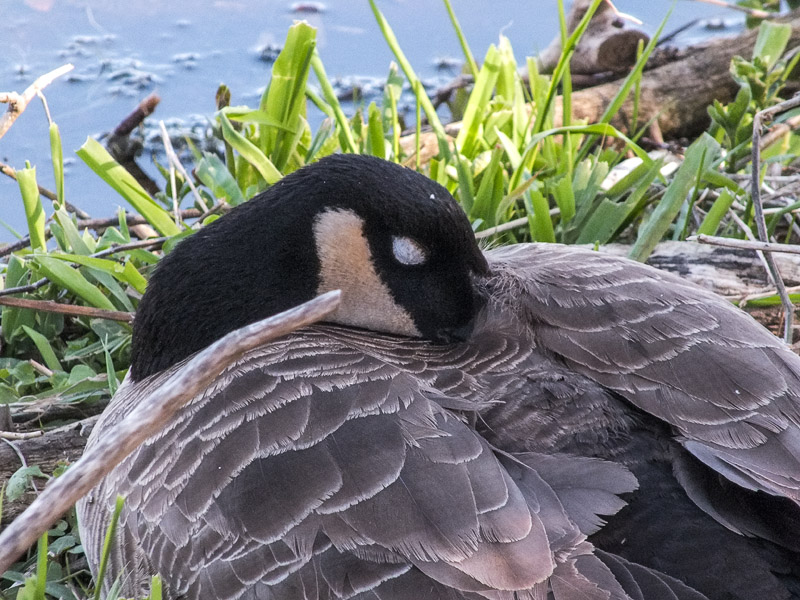
HS25 1000iso f/6.4 1/250 -1/3ev
The shade really takes it toll … 1000ISO is pretty high, yet the image details have not suffered terribly. This cam is a pretty good woods shooter for sure.
Turning our attention to the F770EXR, we find that I managed to capture zero images of the small birds with it. I guess the HS25 asserted it reach too easily. But I did capture a few with the D7000, because the dynamic range and the cropping make that an interesting option despite having less than half the reach of the HS25 with the lens I brought. (More than once, I regretted the absence of the 70-300VR.)
.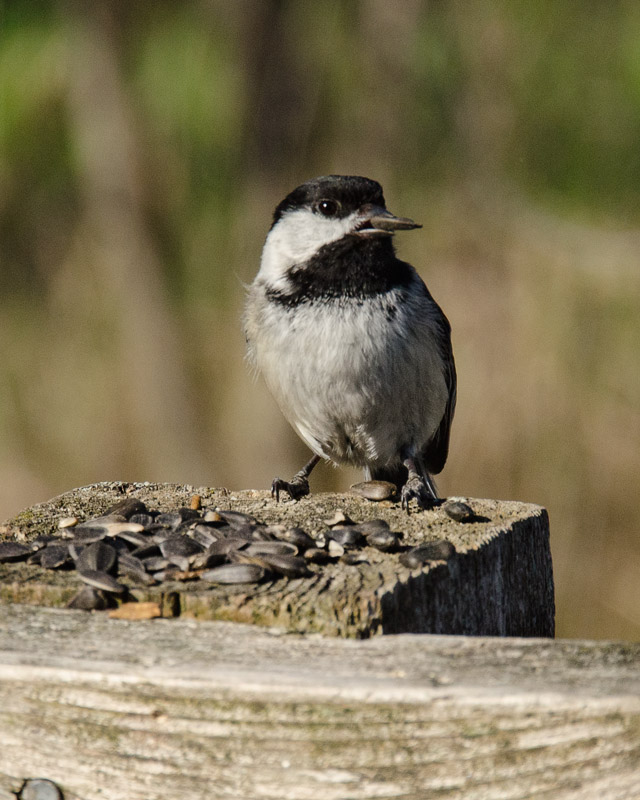
D7000 + 18-200VR 640iso f/10 1/1600 -2/3ev
A nice shot. Not especially better than anything from the HS25, but much easier to capture. Switching to a good VF and a fast responder made the slowness of the bridge cam obvious. The HS25 is a good camera for this sort of shooting, but the D7000 is magnificent. Again … regretting the absence of the better lens.
Pretty good detail on this one …

D7000 + 18-200VR 640iso f/10 1/1250 -2/3ev
Note the very fast shutter speeds. This helps with crispness of course, and is made possible by the higher ISO that is grain free on the D7000.
I was really pleased when the Nuthatch appeared again while I was holding the D7000.
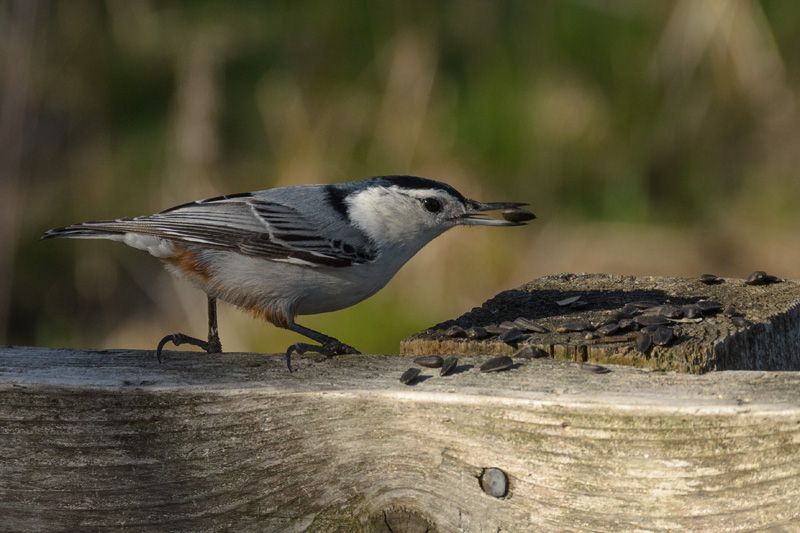
D7000 + 18-200VR 640iso f/10 1/1250 -2/3ev
The dappled sun is making things pretty challenging. But this image is just plain lovely. I am pleased with the composition, the pose, the detail on the bird, the lighting, even the slightly busy bokeh is ok.
This one was possible because of the responsiveness of the D7000. Wicked catch of a startled Chickadee.
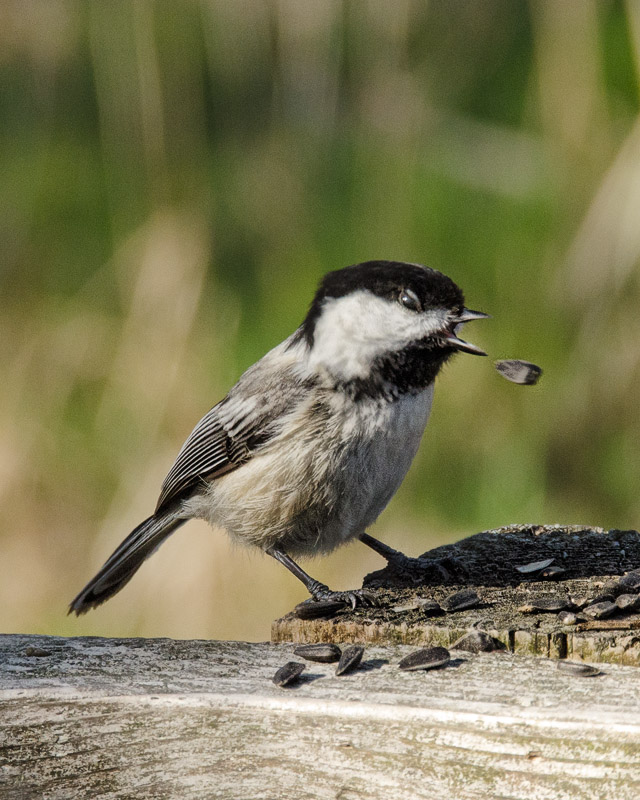
D7000 + 18-200VR 640iso f/10 1/1000 -2/3ev
Not a great image because he snapped his head so quickly, but the eye and the seed are something to see, so there you are.
And another image of the Nuthatch, this one enhanced somewhat in Topaz Adjust. Probably the best image of the day.
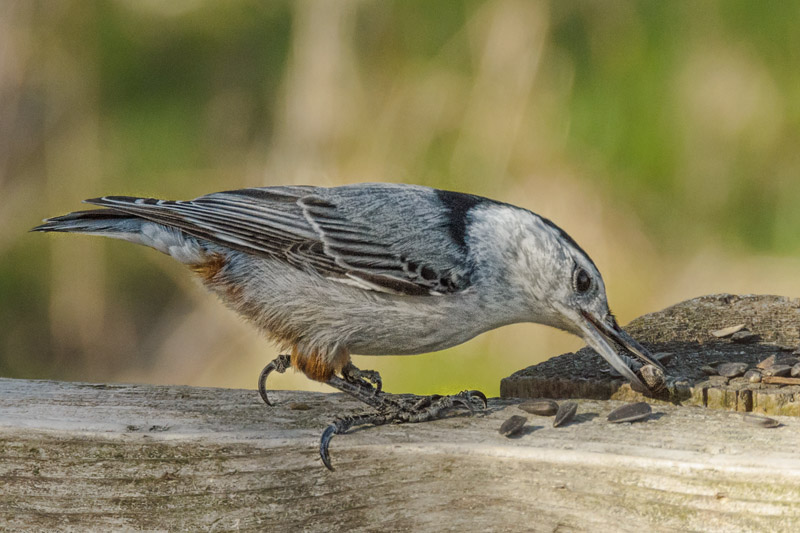
D7000 + 18-200VR 640iso f/10 1/1250 -2/3ev
Wow … let’s just pause to savor that one for a while.
More.
More.
Ok … time to move on.
A long shot of the Blue Jay, cropped. And this will tell you most of what matters about sensor size differences.
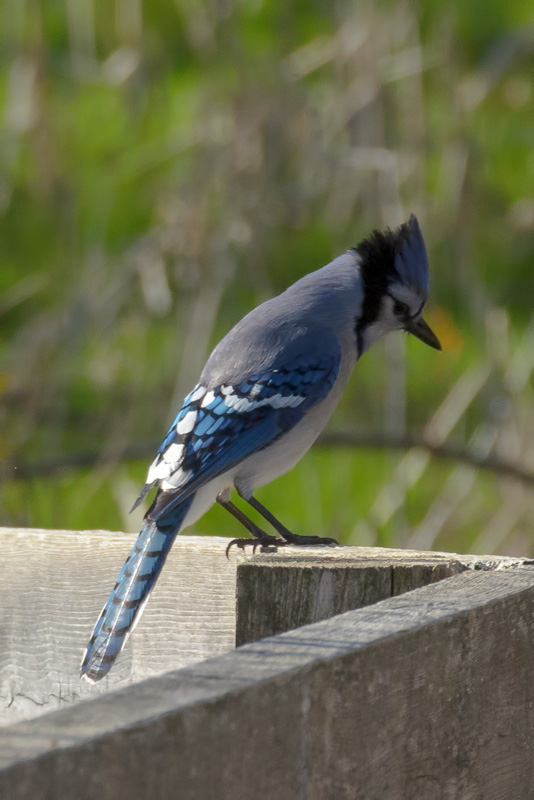
D7000 + 18-200VR 640iso f/10 1/640 -2/3ev
Decent detail for a long shot with a lot of crop.
Ok … enough. That’s a big article, so let’s call it here. There are some more images as I went around the rest of the trail and back to the car. But we’ll get to that in part C.
So what did we observe from these?
- The HS25 JPEG engine is really good. Set with low on all settings, it does not bruise the pixels and thus the processing can bring out a lot of wonderful detail and tone.
- There is no real substitute for optical reach. The larger sensor in the D7000 makes it competitive with this lens, but the HS25 just has a longer one. Period.
- The HS25 is fast enough to capture images of small birds that go to known locations. But you won’t be picking up images of random birds in the bush. It does not focus fast enough at all. The F770EXR is really no better. The D7000 is an absolute pleasure to shoot under such pressure. Even with the all in one lens.
I remain quite pleased with the HS25. I am carrying it almost everywhere now, and I find it quiote comfortable to carry, in ways that the dSLR cannot match because of size and weight. The F770EXR still has the edge, of course, since it easily fits in a pocket.
